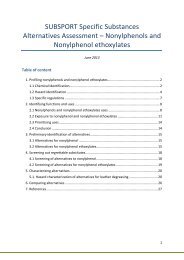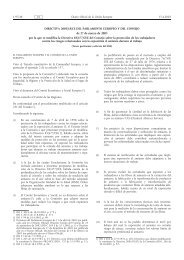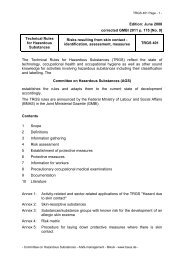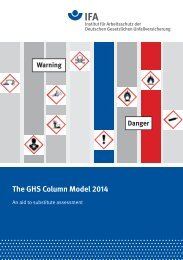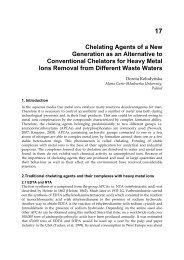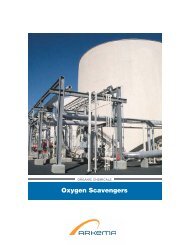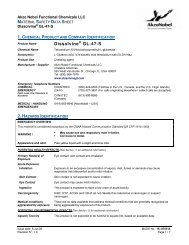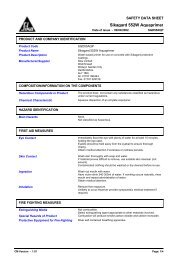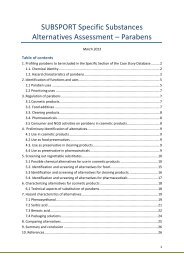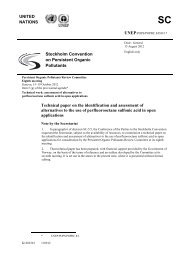Dissolvine® GL Technical brochure - AkzoNobel
Dissolvine® GL Technical brochure - AkzoNobel
Dissolvine® GL Technical brochure - AkzoNobel
Create successful ePaper yourself
Turn your PDF publications into a flip-book with our unique Google optimized e-Paper software.
Dissolvine ® <strong>GL</strong> <strong>Technical</strong> Brochure 5<br />
Solubility<br />
Dissolvine ® <strong>GL</strong> (<strong>GL</strong>DA) has a high water solubility over a wide pH range<br />
(see Figure 4), which is much higher than the classical chelates EDTA<br />
and NTA. Dissolvine ® <strong>GL</strong> also has a high solubility in sodium hydroxide<br />
based systems. Tests with <strong>GL</strong>DA-Na4 have shown much higher solubility<br />
compared to products such as EDTA and NTA sodium salts of (see Figure<br />
5). Good solubility is an important property in the cleaning products as<br />
it enables formulators to make highly concentrated products, which<br />
reduces packaging and transport cost and contributes positively to<br />
conserving the planet.<br />
Experiments with aqueous <strong>GL</strong>DA solutions at temperatures of up to<br />
170°C for 6 hours, or one week at 150°C, show that <strong>GL</strong>DA is extremely<br />
stable especially under alkaline conditions. This is confirmed by literature<br />
on the use of <strong>GL</strong>DA in circulating aqueous systems, e.g. steam generating<br />
and cooling systems (US2004/0011743).<br />
Acid/base dissociation constants<br />
Chelating agents are acids, which can dissociate in water to the chelate<br />
anion and x hydrogen ions (H + ). The extent of acid dissociation is<br />
expressed as the equilibrium constant pK a<br />
. The theoretical values are<br />
shown in Table 2. From the pKa values the ion species distribution of the<br />
<strong>GL</strong>DA molecule as function of the pH can be calculated, see Figure 6.<br />
Figure 4: Solubility of chelating agents, expressed as their acids, in water at<br />
various pH levels<br />
Table 2: The acid dissociation constants (pK a<br />
)* for <strong>GL</strong>DA, NTA and EDTA.<br />
<strong>GL</strong>DA NTA EDTA<br />
pK a1<br />
9.4 9.7 10.2<br />
pK a2<br />
5.0 2.5 6.2<br />
pK a3<br />
3.5 1.8 2.7<br />
pK a4<br />
2.6 1.0 2.0<br />
pK a5<br />
not available 1.5<br />
pK a6<br />
0.0<br />
* A.E. Martell, R.M. Smith, NIST Critically selected stability constants of metal<br />
complexes (NIST standard reference database 46, Version 7.0, 2003)<br />
pK a<br />
values: as determined at an ionic strength of 0.1M and at a temperature of<br />
25°C, or if not available at 20°C.<br />
Figure 5: Solubility of chelating agents in concentrated sodium hydroxide<br />
solution.<br />
Figure 6: The ion species distribution for <strong>GL</strong>DA<br />
Thermal stability<br />
Like most Dissolvine ® aminopolycarboxylates, Dissolvine ® <strong>GL</strong> is very<br />
stable under both acid and alkaline conditions. This is a prerequisite for<br />
stable formulations based on Dissolvine ® <strong>GL</strong>.<br />
The thermal stability of the <strong>GL</strong>DA-Na 4<br />
powder has been determined using<br />
Thermal Gravimetric Analysis (TGA) and Differential Scanning Calorimetry<br />
(DSC). Dissolvine ® <strong>GL</strong> solid loses all its water (10-15%) at temperatures<br />
around 200°C and starts to decompose at temperatures above 300°C.




